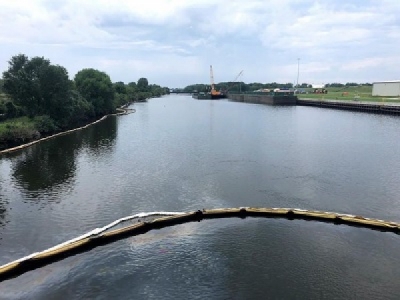
Posted on November 1, 2018
The Army Corps of Engineers has completed another season of dredging in the Indiana Harbor Ship Canal, though a decision on where to store the most toxic sediments remains in limbo.
Contractors working for the Army Corps finished dredging about 250,000 cubic yards of sediment from the federal and nonfederal channel Sept. 21, spokeswoman Vanessa Villarreal said.
In total, the Army Corps has now removed an estimated 1.4 million cubic yards of sediment from the canal and placed it in a previously permitted confined disposal facility at 3500 Indianapolis Blvd. in East Chicago.
The sediments — which contain carcinogenic polychlorinated biphenyls, or PCBs — are shipped by barge to the disposal facility, which was built on the site of the former Sinclair oil refinery.
The refinery operated under various owners from 1918 to 1981, producing products such as mineral spirits, propane, leaded and unleaded gasoline, fuel oil, kerosene, asphalt and asphalt products, liquefied petroleum gas, grease, lubricating oils, paraffin wax, phenols, sulfur and insecticide during those years.
The goal in dredging the ship canal is to prevent the sediment from flowing into Lake Michigan and to make commercial navigation more safe and efficient in the Indiana Harbor Canal, the Army Corps said.
Activists have described the sediments in the ship canal as a “witches brew” and have called for the Army Corps to conduct an environmental dredge that goes deeper than the navigational depth of 20 feet.
The confined disposal facility is less than a half mile from East Chicago Central High School and the new Carrie Gosch Elementary School, which houses some children who were forced to leave the newly-demolished West Calumet Housing Complex in 2016 and 2017 because of lead and arsenic contamination.
The sediments are being stored in water within the clay-lined confined disposal facility, which the Army Corps says was designed to safely contain dredged material. Activists say they believe there is a chance contaminants could become airborne, particularly on windy days.
The Army Corps submitted a risk-based Toxic Substances Control Act application to the Environmental Protection Agency and Indiana Department of Environmental Management in 2014, seeking approval to store an estimated maximum volume of 60,000 cubic yards of sediment containing PCBs concentrations greater than 50 parts per million.
EPA and IDEM gave notice in 2017 they intended to approve the application, but after months of public pressure announced in late 2017 they would study an option for off-site disposal and capping of “hot spots” in the canal.
A decision on whether off-site disposal is a viable option has not yet been announced, the Army Corps said.
The area around hot spots, where PCBs concentrations are greater than 50 ppm, were not disturbed during dredging activities this year and should not have migrated, the Army Corps said.
Source: nwi.com





